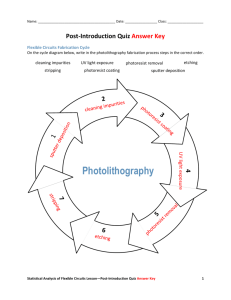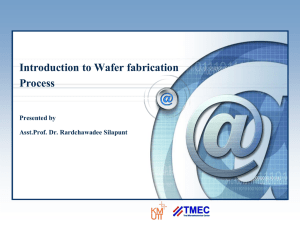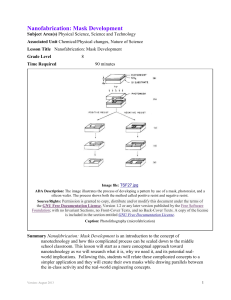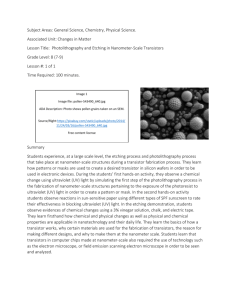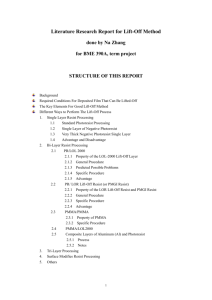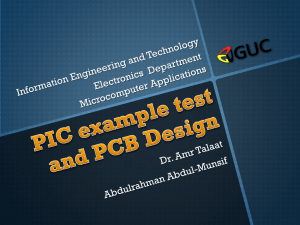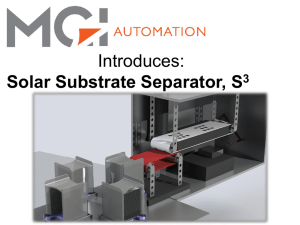Development of High-Performance “Green
advertisement
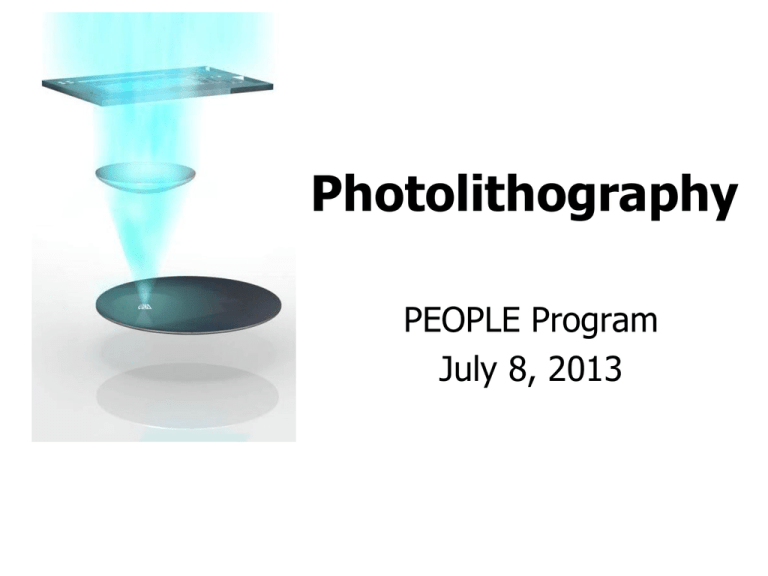
Photolithography PEOPLE Program July 8, 2013 How is Lithography Related to Computers? • Computer chips are made using photolithography Packaging • Instead of drawing with a sharp tip, it uses light to transfer a tiny pattern from a photomask to a lightsensitive chemical Central Processing Unit (CPU) How is Lithography Related to Computers? ENIAC (Electronic Numerical Integrator and Computer) First general-purpose electronic computer Apple II Apple MacBook Air An early personal computer Modern laptop computer weighing only 3 pounds! 65 years… and many advances in photolithography! Photolithography • Role of the Resist: Light exposure changes solubility and allows mask formation • Applications: Making tiny, detailed stuff! For example, microelectronics, microfluidics, MEMS, bioanalytics, sensing, and many more • Main Benefit: High throughput! Geissler, et al. Adv. Mater. 2004, 16, 1249-1269 Transferring the Pattern: Make a Mask! Substrate that will “receive” the pattern Mask that controls the passage of light Silicon wafer Transparency with desired pattern Transferring the Pattern to the Silicon Wafer 1. Coat silicon wafer with photoresist Photoresist Silicon Wafer 2. Tightly place mask on top 3. Expose to UV light Mask Silicon wafer 4. Develop and Rinse ? Depends on the type of photoresist Components of Conventional Photoresist Solvent: gives the resist its flow characteristics Resin: mix of polymers that hold the resist together; gives the resist its mechanical and chemical properties Sensitizers: sensitive to light; these will react when exposed to light Additives: chemicals that control other aspects of the resist material What it mean if something can dissolve? What does it mean if something can’t dissolve? What could be some examples of things that can dissolve in H2O? What could be some examples of things that cannot dissolve in H2O? Our definition Dissolve: A solid loses its structure and becomes dispersed into a liquid.* Examples: •Table salt (NaCl) dissolves in water. •Sand (SiO2) does not dissolve in water. •Gasoline does not dissolve in water. •A breath-strip dissolves in your saliva. *Dissolving can take other forms, as well. For example a gas can dissolve into another gas, or a gas can dissolve into a liquid. Positive vs. Negative Photoresist • Positive Photoresist: Exposed areas become able to dissolve in the developer (so the exposed portion is dissolved by the developer) • Negative Photoresist: Exposed areas become not able to be dissolved in the developer (so the unexposed portion is dissolved by the developer) – We will be using SU-8, a common negative photoresist Positive vs. Negative Photoresist 3. Expose to UV light POSITIVE Photoresist NEGATIVE Photoresist 4. Develop and rinse 4. Develop and rinse 5. Etch patterns into wafer 5. Etch patterns into wafer 6. Remove residual photoresist 6. Remove residual photoresist Make sure you get it! Fill in the blanks: In a _____ photoresist, _____ light reacts with the photoresist to make it unable to be dissolved, so it is rinsed away by the _____. 3. Expose to UV light POSITIVE Photoresist NEGATIVE Photoresist 4. Develop and rinse 4. Develop and rinse 5. Etch patterns into wafer 5. Etch patterns into wafer 6. Remove residual photoresist 6. Remove residual photoresist A Common Photoresist: SU-8 • “Traditional” epoxy resin negative photoresist • UV sensitized with a cationic polymerization initiator • Low near-UV optical absorption high aspect ratio (>15) features EPON® Resin SU-8 (Shell Chemical) Hg “I-line”, 365 nm Lee, et al. JVSTB 1995, 13, 3012-3016; Bertsch, et al. Sens. Actuators 1999, 73, 14-23; Lin, et al. J. Micromech. Microeng. 2002, 12, 590-597; Liu, et al. Adv. Mater. 2007, 19, 3783-3790 Review! What is cross-linking? Do you think that a substance that has a lot of cross-links would be more easily or less easily dissolved? Why do you think so? Negative Photolithography Unexposed areas remain able to be dissolved by developer chemical. Areas exposed to light become crosslinked and don’t dissolve in the developer chemical. UV Photoresist Oxide Substrate Unexposed Exposed Soluble Pre-exposure - photoresist Crosslinks Post-exposure - photoresist Post-develop - photoresist Today’s Activity: Photolithography • Bucky masks have been created for you • Glass slides have been primed and coated SU-8 photoresist Your Mask: • You will be performing photolithography using these masks PEOPLE Program 2013 Your Name Today’s Activity: Photolithography UV Light Resist Mask 1) Vapor prime 2) Spin coat 3) Soft bake 5) Post-exposure bake 6) Develop 7) Hard bake 4) Alignment and Exposure 8) Inspect Step 1: Vapor Prime The First Step of Photolithography: • Wafer “primed” for photoresist deposition by cleaning with isopropanol and acetone • Promotes good photoresist-towafer adhesion • Followed by dehydration bake (200 °C, 5 min) Silicon Wafer Ensures wafer surface is clean and dry Step 2: Spin Coat Photoresist on Wafer 1. Wafer secured to vacuum chuck of spin coater 2. Dispense ~3 mL of photoresist onto wafer 3. Slow spin: 500 rpm for 15 s 4. Fast spin: 6000 rpm for 60 s • Quality measures: – time – speed – thickness – uniformity – particles and defects Photoresist dispenser Vacuum chuck To vacuum pump Spindle connected to spin motor Steps of Photoresist Spin Coating 1) Resist dispense 3) Spin-off 2) Spin-up 4) Solvent evaporation Step 3: Soft Bake • Improves photoresist-towafer adhesion • Promotes resist uniformity on wafer • Drives off most solvent in photoresist • Improves linewidth control during subsequent development/etching steps • Our soft bake procedure: – T = 95 °C on hot plate – t = 2 min – Cool to room temperature Silicon wafer coated with photoresist Hot plate (T = 95 °C) Step 4: Alignment and Exposure • Exposure transfers the mask pattern to the photoresist-coated wafer • Light activates the photosensitive components of photoresist • Quality measures: – linewidth resolution – overlay accuracy – particles and defects UV light source Mask Resist Step 5: Post-Exposure Bake Silicon wafer coated with exposed photoresist • Performed immediately after exposure • Completes the photo reaction initiated during exposure • Same procedure as the pre-exposure soft bake: – T = 95 °C on hot plate Hot plate (T = 95 °C) – t = 2 min – Cool to room temperature Step 6: Photoresist Development • Soluble areas of photoresist are dissolved by developer solvent • Can be performed on the spin coater or simply by immersing in the developer • Visible patterns appear on wafer: windows, islands, lines, text, images, … • Quality measures: - line resolution - uniformity - particles and defects Developer dispenser Vacuum chuck To vacuum pump Spindle connected to spin motor Steps 7 and 8: Hard Bake and Inspect • Hard bake step increases thermal, chemical, and mechanical stability of developed resist features. • Developed resist features can be inspected (usually with magnification) to assess the quality of pattern transfer. Summary 1. Coat wafer with photoresist Photoresist Silicon Wafer 5. Etch patterns into wafer 2. Tightly place mask on top 3. Expose to UV light 6. Remove residual photoresist 4. Develop and rinse Today’s Activities Group 1 • • • • • Jake & Zahmere Ruby & Tyrice Roselena & Manuel Paola & Shealyn Terry & Mario Group 2 • • • • • Champange & Jazmin Alvaro & Karen Tashiana & Tabitha Mariah & Zantasia Alma & Sara Today’s Activities Si Wafers (Diane, Ben & Kelly) Photolithography (Matt & Alfonso) Session 1 Group 1 Group 2 Session 2 Group 2 Group 1
